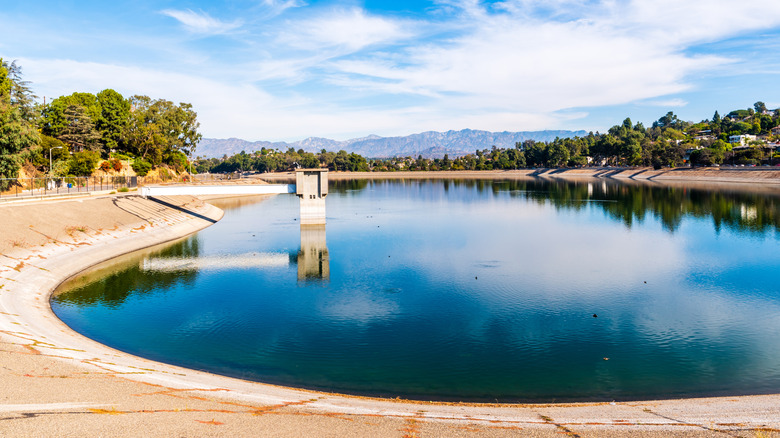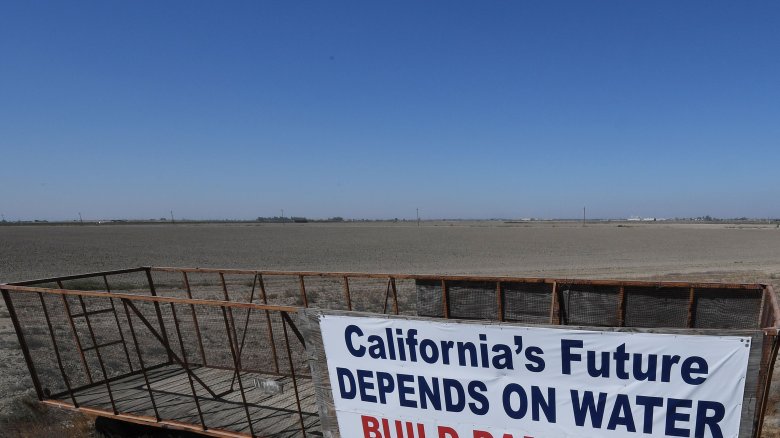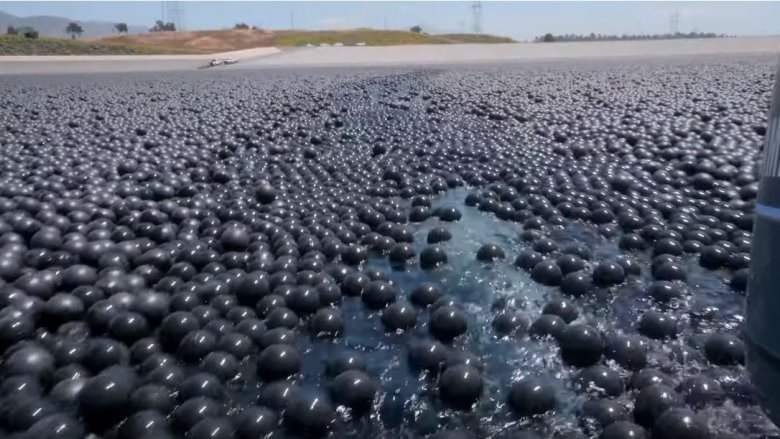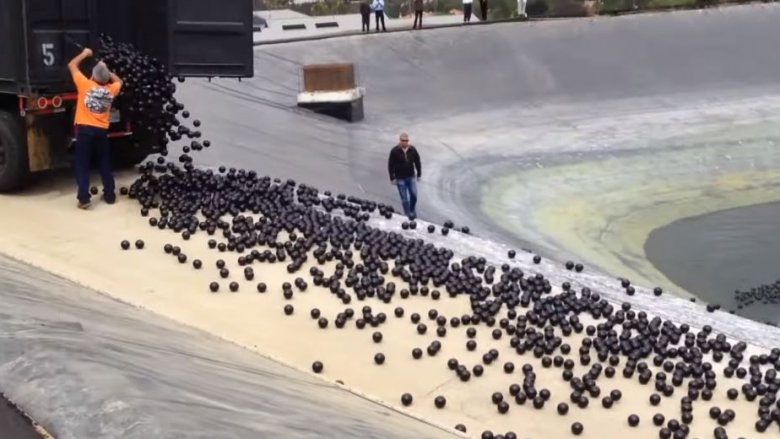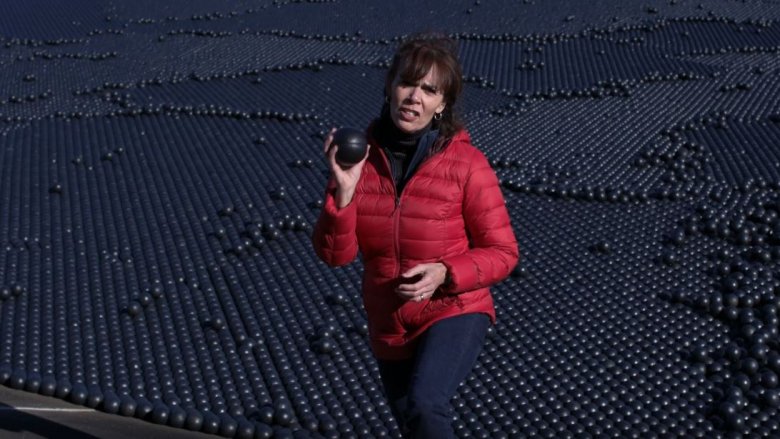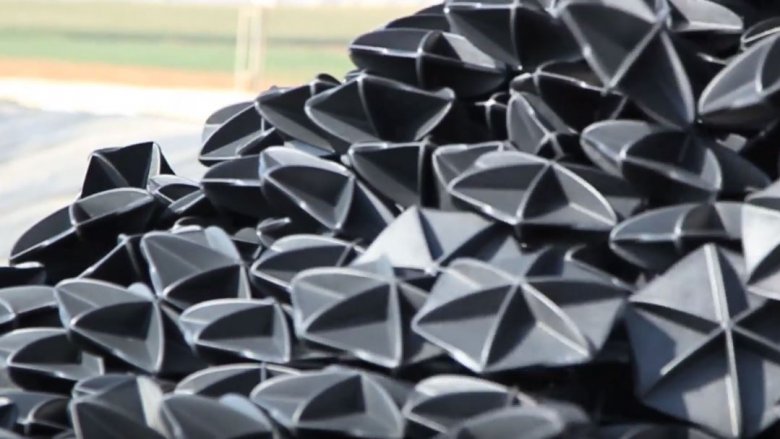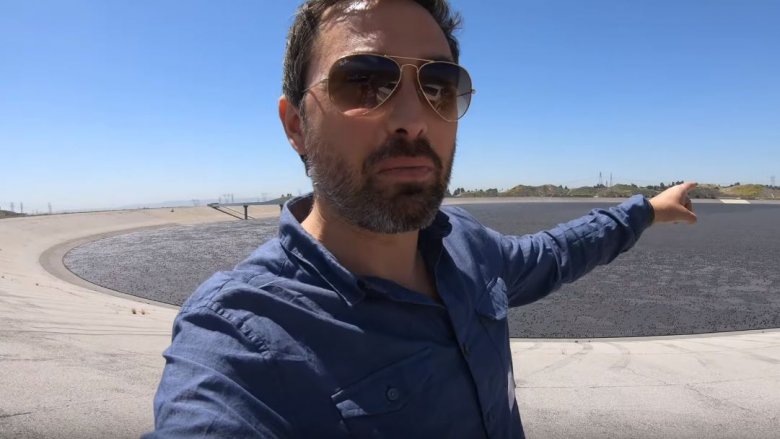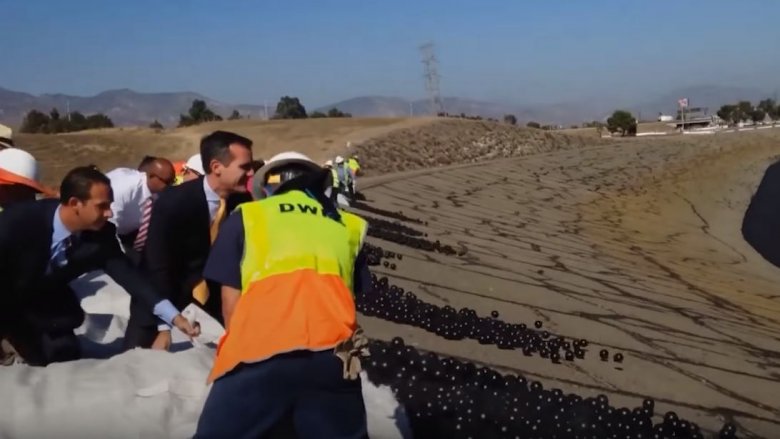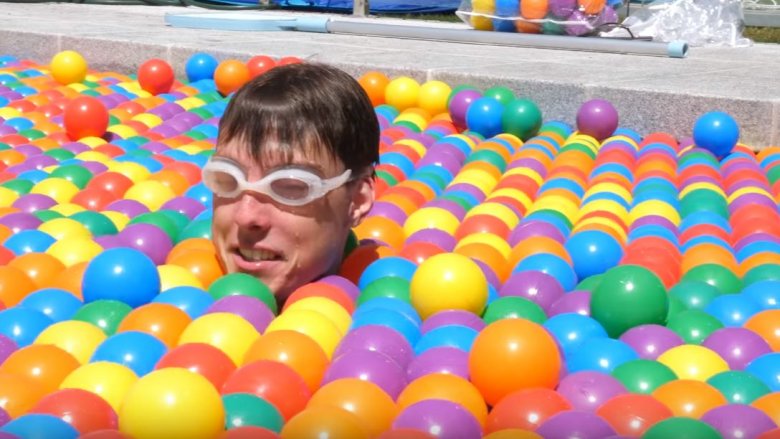The Real Reason This Reservoir Is Covered In 96,000,000 Black Balls
If you're the kind of person who kills time by scrolling through silly Facebook memes at work you've probably seen those wacky videos of Los Angeles dumping 96 million black balls into its drinking water. The footage looks like a scene out of some low-budget political satire, but nah, this is the world you live in.
Weird? You bet. A good idea? Well, there's some debate on that. Given that the words "California" and "drought" have been headline partners for most of the last decade or so, many people assume the so-called "shade balls" are a high-tech water-saving technique. In reality, the proper function of shade balls is far more complex. So strap on your thinking cap, and don't overheat in the Sun: It's time to learn how these things became a quirky Los Angeles tourist attraction before you go dump a few million of them into your swimming pool.
This one's for the birds
Okay, so dumping 96 million shade balls into a body of water makes for an awesomely surreal visual. Up on Planet X, all the aliens are laughing. But no government on Earth would ever spend so much money just to create a goofy viral video, so there's obviously a bigger explanation.
Where did these things come from? They were formerly known as "bird balls," according to Governing, due to their use as avian deterrent. Birds aren't afraid of them, but a round and slippery surface is pretty difficult to land on compared to regular water. So if you fill a pond with these things, the birds are going to go elsewhere. The Toronto Star reports that these rubbery spheres were originally created for mining, as a way to keep the feathered friends from getting poisoned by toxic waste in tailing ponds.
The balls then migrated to the airline industry, as reported by Science Alert, where airports dumped them into drainage ponds. Again, this was to deter birds because nobody wants to see Mr. Joe Seagull get sucked into a jet engine and make a bloody mess ... much less cause an airplane crash.
It's not really about drought prevention
Whenever you see the words "California" and "water" together, your first thought is probably "drought." So when you hear that Los Angeles has a reservoir filled covered with millions of balls, you made the natural assumption that they did it to help the drought. Makes sense, right?
Wrong. While the Golden State did tout these benefits, that wasn't the real reason for the great shade ball avalanche. If anything, drought assistance was just a nice PR bonus. Yes, shade balls do help with water evaporation, according to Los Angeles Weekly, but if shade balls really had been financed purely as a drought solution, that would have been pretty dumb.
That said, pointing to the drought definitely helped sell the whole, "Hey, we're turning our reservoirs into giant ball pits, guys," story, so you can't blame California for the marketing.
Loads of benefits
The water loss benefits that are provided by shade balls partly come from their carbon black color. According to National Geographic, pouring a nice blanket of dark spheres over a reservoir prevents that hot California sun from breaking through, thereby keeping the water beneath much cooler. Lower temperatures equals less evaporation. In this way, shade balls reduce water loss by about 300 million gallons a year, which is pretty good for a side gig.
The dark orbs have other fringe benefits, as well. For example, the use of shade balls cuts down on algae growth in reservoirs, according to Science Alert, and having fewer toxic organisms swimming in your drinking water is undeniably a good thing. This toxicity reduction also means the treatment facilities don't have to use as much chlorine. Best of all, Aquarius Systems points out that shade balls come in at pretty good price, about three or four for a dollar. Obviously you'd have to order them in bulk, though, to get that kind of rate.
Oh boy, here comes the science stuff
Okay, it's scientific jargon time, so hang tight. In order to understand the actual function of shade balls, you must first grasp a little bit of the chemistry.
While it's understandable that the average person might feel concerned about the numerous chemicals in their water supply, chemicals aren't inherently bad. Drinking so-called "raw water" isn't good for you, as Time points out, as safe tap water is treated (yes, with chemicals) to remove dozens of different contaminants that could be hazardous to your health. While this treatment is a good thing, it can sometimes cause unforeseen problems, and that's what happened to the reservoirs in the Los Angeles area in 2009, as explained by the California Environmental Protection Agency: The water in the reservoirs contained both residual chlorine and a chemical compound called bromide.
Following? Cool. Now, to be clear, neither of these ingredients, in small amounts, are anything to worry about ... usually. However, when you introduce a certain third element to the cocktail, that's when the problems start.
It's not all fun and balls
Okay, so in 2007, the city tested the reservoirs, and found that the big yellow hot thing in the sky was causing havoc with the chemicals. According to the California Environmental Protection Agency, the delightful southern California sunlight interacted with the chlorine in such a way that the bromide was turned into something called "bromate."
Extraordinarily uncool because bromate is believed to be carcinogenic. Big whoops. In California, water is gold, so nobody was happy when the City of Angels was forced to drain 600 million gallons of drinking water — an entire day's supply — due to bromate contamination, according to Chemical and Engineering News. Bad optics, worse results. This disaster left Los Angeles desperate for a solution that wasn't easy to come by: When you have a giant, treated, outdoor water supply, how do you block it from a ball of heat bigger than the planet? Innovation was necessary.
Go away, Sun
Enter shade balls, a creative (and cheaper) solution to a weird problem. The first guy to suggest using them, according to National Geographic, was Dr. Brian White. Can you imagine the looks he got in that conference room? However, once research showed that bird balls would indeed prevent bromate formation, both L.A. Mayor Eric Garcetti and the Los Angeles Department of Water and Power were on board. Vox says these bouncy do-gooders were first dropped into various California reservoirs back in 2008, but it wasn't until their 2015 addition to the enormous Los Angeles Reservoir at Sylmar that videos went viral. By this time, the drought had set in, so Garcetti made sure to mention those popular water evaporation benefits.
The Toronto Star explains that shade balls prevent bromate formation because they are constructed from high-density polyethylene, a material resistant to ultraviolet light. When enough shade balls are deployed to completely cover a water surface (hence, why you need gajillions of the suckers) they dramatically reduce the sunlight hitting the water, while also reducing the wind's effect on the water. In order to make sure the balls don't go flying around the countryside, each one is filled with 200 grams of water. No sunlight on the water, no breeze, no bromate, voila!
Basically, the balls cover the water, keep away things like sunlight and bird poop, and thus prevent bad chemicals forming. Sometimes the most bizarre things work for the easiest reasons.
Alternative methods
Okay, so 96 million black balls are about as "alternative" as you get, and honestly, there are several more conventional solutions to the problem that California faced. Less fun, but hey.
The obvious one is, predictably, the same sort of thing you'd cover your pool with. These so-called "floating covers," according to MPC Containment, are used around the world to protect against rainwater, mud, bird poop, or whatever weird crap vandals might dump into it. You know, the basics. For most reservoirs, floating covers are a more effective solution than shade balls, but when it came to the 175-acre Los Angeles Reservoir, the installation of a traditional floating cover would have been ludicrously expensive, to the tune of $250 million. Hence why Los Angeles found a cheaper way to go.
Another potential alternative? The funky Hexa-Cover floating pieces from Denmark, used in places like Israel, which function similarly to shade balls but are shaped like hexagons instead of spheres. They don't have the cute factor of shade balls, but they are pretty nifty. (With its sloped sides, the LA Reservoir needed something — like balls — that would roll back down as the water level fluctuated.)
A rare attraction
As cool as shade balls might be, don't count on seeing them fill up reservoirs across the country. According to Governing, the specific problems that took place within the various Los Angeles reservoirs, which created the natural formation of bromate, were a unique set of circumstances that are unlikely to occur in other parts of the country. Uh, bummer?
To be frank, though, even Los Angeles has cooled off a bit from their shade ball mania. Between 2008 and 2015, the city poured the balls into all four of their open-air reservoirs — the Los Angeles Reservoir, Ivanhoe, Elysian, and Upper Stone Canyon — but today, these bodies of water have become less bouncy. That's because, as boring as those "floating covers" are, they do work better, so the shade balls were removed from all except the Los Angeles Reservoir. That one only got to keep its shade balls because, at 175 acres, it would just be ridiculously expensive to install and maintain a floating cover. So while it'd be cool to imagine shade balls taking off across the country, the reality is that they're probably just going to be an awfully weird blip in the history books, maybe useful for a trivia night in about 30 years.
The dark side of the shade
Shade balls in the Los Angeles Reservoir can save up to 300 millions gallons of water a year. That's enough to supply drinking water for 8,100 Californians. Good news? Absolutely. On the other hand, what if producing those shade balls means sucking up somebody else's water, to an excessive degree? Not so good.
In 2018, PBS reported that a joint study by the Massachusetts Institute of Technology, the Imperial College London, and the University of Twente in the Netherlands found that it might take more water to produce shade balls than the amount they would save. The high-density polyethylene the balls are made of requires natural gas, oil, and electricity — three things we use water to get — and the study found that manufacturing the famous 96 millions balls required using up from 66 to 766 million gallons of water. Assuming that visualizing water gallons isn't your thing, that's a range from 100 to 1,000 Olympic swimming pools. Jeez.
Scary as this sounds, there is a silver lining, according to Science Alert: One, shade balls are fully recyclable, and two, they are supposed to last for at least a decade. That latter point matters because in order for the shade balls to legitimately save water — i.e. to recover the water used to make them and then some — they have to be deployed for at least a year or two. So shade balls do save water, in the end, but it takes them a little while to get there.
So c'mon, are they fun to play in?
If you're ever hanging out in Los Angeles, don't jump in the giant ball pit, no matter how fun it looks. As Veritasium makes clear, navigating a boat through those suckers is intensely difficult, since the balls — which, remember, are filled with water — form tight clusters that quickly pull back together when parted. This is what keeps them from simply blowing away in the wind, but it also makes them a challenge for even the most experienced boat driver, much less a swimmer.
Because of this, whenever a boat wades into the balls, anyone who gets on board is required to wear a life jacket. Can you imagine getting stuck underneath those things, gasping for air, as you desperately try to swim upward while the balls push you down? It sounds like a death scene from a cheesy '50s B-horror movie.
